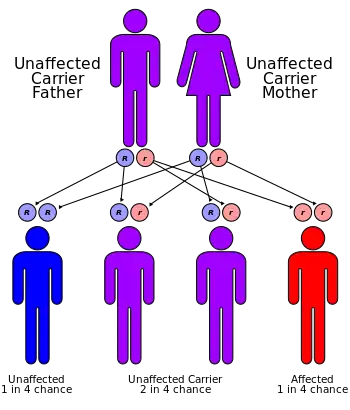Familial isolated vitamin E deficiency
| Familial isolated vitamin e deficiency | |
|---|---|
| Other names: Ataxia With Vitamin E Deficiency , AVED | |
 | |
| Familial isolated vitamin E deficiency has an autosomal recessive pattern of inheritance. | |
| Treatment | high-dose oral vitamin E supplementation |
| |
Familial isolated vitamin E deficiency or Ataxia with vitamin E deficiency (AVED) is a rare autosomal recessive neurodegenerative disease.[1][2][3][4] Symptoms are similar to those of Friedreich ataxia.
Signs and symptoms
The clinical presentation of AVED in an affected individual is as follows:[5]
Cause
Familial isolated vitamin E deficiency is caused by mutations in the gene for a-tocopherol transfer protein.[6] Symptoms manifest late childhood to early teens. [7]
Diagnosis
In terms of the diagnosis of Ataxia with Vitamin E Deficiency done via clinical evaluation and a variety of tests (low levels of vitamin E with normal levels of lipoproteins).[5]
Treatment
Treatment includes vitamin E therapy, where lifelong high-dose oral vitamin E supplementation is prescribed to maintain plasma vitamin E concentrations and monitoring vitamin E levels in blood plasma.[7]
See also
- Vitamin E deficiency
- TTPA
References
- ↑ "Ataxia with vitamin E deficiency". www.orpha.net. Archived from the original on 2017-01-31. Retrieved 2017-01-19.
- ↑ Doerflinger N, Linder C, Ouahchi K, Gyapay G, Weissenbach J, Le Paslier D, Rigault P, Belal S, Ben Hamida C, Hentati F (May 1995). "Ataxia with vitamin E deficiency: refinement of genetic localization and analysis of linkage disequilibrium by using new markers in 14 families" (Free full text). American Journal of Human Genetics. 56 (5): 1116–24. ISSN 0002-9297. PMC 1801469. PMID 7726167.
- ↑ Reference, Genetics Home. "ataxia with vitamin E deficiency". Genetics Home Reference. Archived from the original on 2017-01-18. Retrieved 2017-01-19.
- ↑ Schuelke, Markus (1993-01-01). "Ataxia with Vitamin e Deficiency". In Pagon, Roberta A.; Adam, Margaret P.; Ardinger, Holly H.; Wallace, Stephanie E.; Amemiya, Anne; Bean, Lora J.H.; Bird, Thomas D.; Ledbetter, Nikki; Mefford, Heather C. (eds.). GeneReviews. Seattle (WA): University of Washington, Seattle. PMID 20301419. Archived from the original on 2022-10-17. Retrieved 2022-11-13.
- 1 2 "Ataxia with Vitamin E Deficiency - Symptoms, Causes, Treatment | NORD". rarediseases.org. Archived from the original on 19 January 2022. Retrieved 3 March 2023.
- ↑ Cellini E, Piacentini S, Nacmias B, Forleo P, Tedde A, Bagnoli S, Ciantelli M, Sorbi S (Dec 2002). "A family with spinocerebellar ataxia type 8 expansion and vitamin E deficiency ataxia". Archives of Neurology. 59 (12): 1952–53. doi:10.1001/archneur.59.12.1952. ISSN 0003-9942. PMID 12470185.
- 1 2 Schuelke, Markus (2016-10-13). "Ataxia with Vitamin E Deficiency". NCBI Bookshelf. PMID 20301419. Archived from the original on 2022-10-17. Retrieved 2022-11-13.
External links
- Ataxia with vitamin E deficiency at NIH's Office of Rare Diseases
| Classification |
|---|